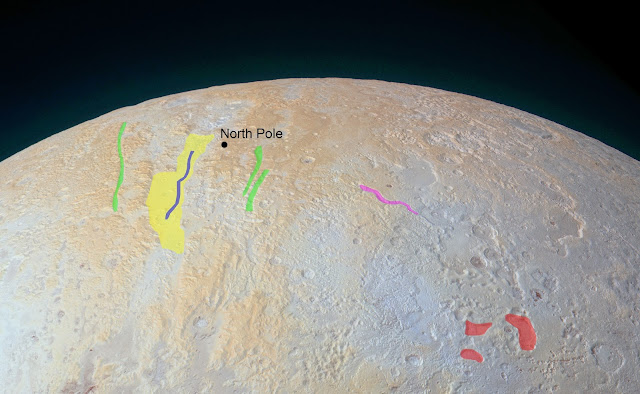Summary: New Horizons spacecraft captures Plutonian north polar frozen canyons in a color enhanced image released Thursday, Feb. 25, by NASA.
Plutonian north polar frozen canyons are captured in a color enhanced image taken by the New Horizons spacecraft and released Thursday, Feb. 25, 2016, by the National Aeronautics and Space Administration (NASA).
The image’s enhanced color emphasizes the unusual color and composition of Pluto’s north polar region. A distinctive yellow, not evinced elsewhere on Pluto, identifies high elevations. Canyons cut vertically through the polar area. The widest of the Plutonian north polar frozen canyons paints a huge yellow swath, about 45 miles (75 kilometers) in width, near Pluto’s north pole.
Subsidiary canyons display parallel formations to the east and west of the wide canyon. Indicated in green, they measure widths of approximately 6 miles (10 kilometers).
NASA’s New Horizons Mission scientists perceive the Plutonian north polar frozen canyons as older than the more sharply featured canyon systems found elsewhere on the dwarf planet. The Plutonian north polar frozen canyons exhibit degraded walls and appear to be composed of weak materials. Scientists interpret the north polar canyons’ features as indicative of ancient tectonics, or internally-directed crustal movements.
The area’s predominantly yellowish landscape transitions to blue grey at lower elevations. A shallow valley, indicated in blue, spans the entire winding length of the widest of the Plutonian north polar frozen canyons.
Pluto’s north polar region abounds in methane ice and holds little nitrogen ice, according to infrared measurements by the sensitive New Horizons spacecraft.
“One possibility is that the yellow terrains may correspond to older methane deposits that have been more processed by solar radiation than the blue terrain,” Will Grundy, New Horizons composition team lead from Flagstaff, Arizona’s Lowell Observatory, suggests in NASA’s Feb. 25 news release.
Other features colorfully identifiable in New Horizons spacecraft’s enhanced image include a pink-highlighted valley snaking diagonally to the southeast of Pluto’s north pole. Further to the southeast, roughly shaped pits, depicted in red, gouge the landscape. The pits span 45 miles (70 kilometers) and plunge to a depth of 2.5 miles (4 kilometers). NASA scientists consider the collapsed, pitted terrain as caused by melted or sublimated (solid-to-gas converted) subsurface ice.
The closeup of the Plutonian north polar frozen canyons was captured by the New Horizons’ Ralph/Multispectral Visible Imaging Camera (MVIC). Seven Charge-Coupled Device (CCD) detectors enable the imager to perceive visible and near-infrared wavelengths. Four detectors produce hemispheric maps via methane, red, blue and near-infrared color filters. The other three detectors rely on panchromatic filters to tackle faint light levels with maximum sensitivity.
The image of the Plutonian north polar frozen canyons resolves to approximately 2,230 feet (680 meters) per pixel. The closeup covers a distance of about 750 miles (1,200 kilometers) at the image’s lower edge.
The Ralph/Multispectral Visible Imaging Camera obtained the image Tuesday, July 14, 2015, at a distance of approximately 21,100 miles (33,900 kilometers) from Pluto. The image was captured about 45 minutes before the spacecraft’s closest flyby of the dwarf planet.
The first-ever closeups of the Plutonian system, taken July 14, 2015, by the New Horizons spacecraft downlinks two months later, Saturday, Sept. 19.
On Thursday, Sept. 24, John Spencer, a New Horizons Geology, Geophysics and Imaging (GGI) team deputy lead from Boulder, Colorado’s Southwest Research Institute (SwRI), describes the first views of the high resolution, milestone images in a news announcement released by the Johns Hopkins Applied Physics Laboratory:
“We used MVIC’s infrared channel to extend our spectral view of Pluto. Pluto’s surface colors were enhanced in this view to reveal subtle details in a rainbow of pale blues, yellows, oranges, and deep reds. Many landforms have their own distinct colors, telling a wonderfully complex geological and climatological story that we have only just begun to decode.”
 |
| frozen canyons of Pluto's north pole: NASA @NASA via Twitter Feb. 25, 2016 |
Acknowledgment
My special thanks to talented artists and photographers/concerned organizations who make their fine images available on the internet.
Image credits:
Image credits:
Plutonian north polar frozen canyons: NASA/JHUAPL (Johns Hopkins Applied Physics Laboratory)/SwRI (Southwest Research Institute), Public Domain, via NASA @ https://www.nasa.gov/feature/the-frozen-canyons-of-pluto-s-north-pole
frozen canyons of Pluto's north pole: NASA @NASA via Twitter Feb. 25, 2016, @ https://twitter.com/NASA/status/702969447980666880
For further information:
For further information:
Brown, Dwayne; Michael Buckley; and Maria Stothoff. "NASA's New Horizons Spacecraft Nears History July 14 Encounter with Pluto." NASA > Press > Pluto. April 14, 2015.
Available @ https://www.nasa.gov/press/2015/april/nasa-s-new-horizons-spacecraft-nears-historic-july-14-encounter-with-pluto
Available @ https://www.nasa.gov/press/2015/april/nasa-s-new-horizons-spacecraft-nears-historic-july-14-encounter-with-pluto
Marriner, Derdriu. "Colorful NASA Map Spotlights Plutonian Heart Shaped Tombaugh Regio." Earth and Space News. Monday, Feb. 15, 2016.
Available @ https://earth-and-space-news.blogspot.com/2016/02/colorful-nasa-map-spotlights-plutonian.html
Available @ https://earth-and-space-news.blogspot.com/2016/02/colorful-nasa-map-spotlights-plutonian.html
Marriner, Derdriu. "High Resolution Images From New Horizons Flyby Past Pluto." Earth and Space News. Monday, Dec. 7, 2015.
Available @ https://earth-and-space-news.blogspot.com/2015/12/high-resolution-images-from-new.html
Available @ https://earth-and-space-news.blogspot.com/2015/12/high-resolution-images-from-new.html
Marriner, Derdriu. "Ice Volcanoes May Erupt Ammonia, Methane, Nitrogen or Water on Pluto." Earth and Space News. Friday, Nov. 13, 2015.
Available @ https://earth-and-space-news.blogspot.com/2015/11/ice-volcanoes-may-erupt-ammonia-methane.html
Available @ https://earth-and-space-news.blogspot.com/2015/11/ice-volcanoes-may-erupt-ammonia-methane.html
McKinnon, Mika. "We're Actively Creating the Geekiest World in the Universe." Space Gizmodo. Aug. 1, 2015.
Available @ http://space.gizmodo.com/were-actively-creating-the-geekiest-world-in-the-univer-1721448557
Available @ http://space.gizmodo.com/were-actively-creating-the-geekiest-world-in-the-univer-1721448557
NASA @NASA. "You've never seen Pluto like this!" Twitter. Feb. 25, 2016.
Available @ https://twitter.com/NASA/status/702969447980666880
Available @ https://twitter.com/NASA/status/702969447980666880
"Perplexing Pluto: New 'Snakeskin' Image and More from New Horizons." Johns Hopkins Applied Physics Lab > New Horizons: NASA's Mission to Pluto > News Center. Sept. 24, 2015.
Available @ http://pluto.jhuapl.edu/News-Center/News-Article.php?page=20150924
Available @ http://pluto.jhuapl.edu/News-Center/News-Article.php?page=20150924
Talbert, Tricia, ed. "The Frozen Canyons of Pluto's North Pole." NASA > Feature > New Horizons. Feb. 25, 2016.
Available @ https://www.nasa.gov/feature/the-frozen-canyons-of-pluto-s-north-pole
Available @ https://www.nasa.gov/feature/the-frozen-canyons-of-pluto-s-north-pole
Talbert, Tricia, ed. "The Tartarus Dorsa Mountains Rise Up Along Pluto." NASA > New Horizons. Sept. 24, 2015.
Available @ https://www.nasa.gov/image-feature/the-tartarus-dorsa-mountains-rise-up-along-pluto
Available @ https://www.nasa.gov/image-feature/the-tartarus-dorsa-mountains-rise-up-along-pluto

No comments:
Post a Comment
Note: Only a member of this blog may post a comment.